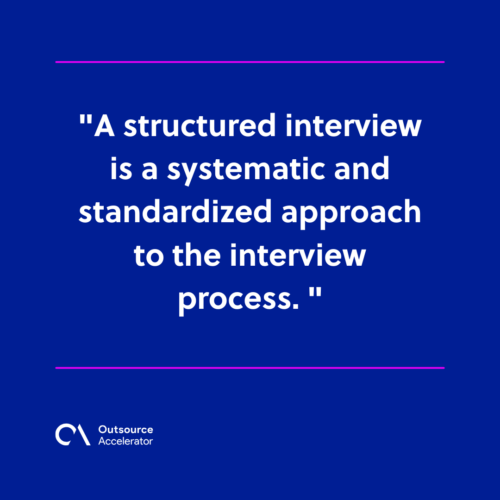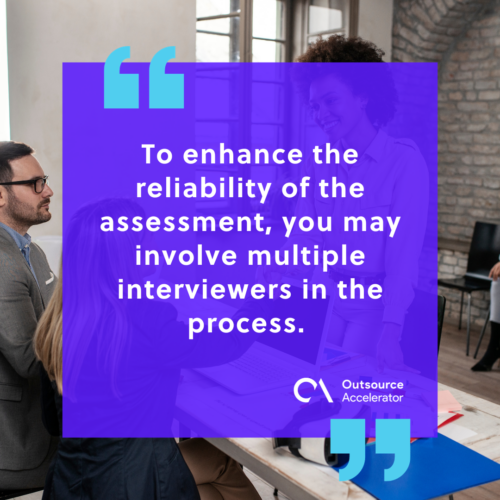Structured interviews: A quick guide

Effective interview preparation is crucial for evaluating candidates—every efficient employer knows this. Some may even have their own sets of interview strategies.
Thorough preparation not only leads to improved hiring outcomes but also streamlines the entire interview process.
However, one interview style that is often overlooked is conducting structured interviews.
While this may seem easy to conduct, it requires careful planning, with predefined questions and a consistent rating system.
Let’s define what a structured interview is and how to conduct it with shortlisted candidates.
What is a structured interview?
A structured interview is a systematic and standardized approach to the interview process.
Unlike unstructured interviews, where questions can vary widely, a structured interview involves a predetermined set of questions and a standardized scoring system.
The goal is to ensure that each candidate is assessed consistently and fairly based on the same criteria. It helps minimize biases and subjectivity in the evaluation, providing a more objective and reliable means of selecting candidates for a job.

Sample questions for a structured interview
Here are two sample questions of a structured interview and how you can score the candidates based on their answers:
| Question #1: | Significance |
| Can you give an example of a challenging situation you faced in a previous role? How did you successfully resolve it? | This question helps evaluate the candidate’s ability to handle challenges and solve problems effectively. |
Scoring guide:
Clarity and detail (0-5)
0: Incoherent or vague response
1-2: Limited details, unclear explanation
3-4: Adequate details but lack depth
5: Clear, detailed, and comprehensive response
Problem-solving skills (0-5)
0: No evidence of problem-solving
1-2: Minimal problem-solving demonstrated
3-4: Adequate problem-solving skills shown
5: Strong evidence of effective problem-solving
Outcome and success (0-5)
0: No resolution or unsuccessful resolution
1-2: Limited success or unclear outcome
3-4: Moderate success, resolution achieved
5: Clear success and positive resolution
| Question #2: | Significance |
| Can you describe a situation where you had to collaborate with a diverse team to achieve a common goal? How did you contribute to the team’s success? | This question provides insights into the candidate’s communication, teamwork, and leadership capabilities. |
Scoring guide:
Communication and collaboration (0-5)
0: Lack of communication or collaboration
1-2: Minimal evidence of effective communication or collaboration
3-4: Adequate communication and collaboration skills demonstrated
5: Strong evidence of effective communication and collaboration
Contribution to team’s success (0-5)
0: No contribution or negative impact on the team
1-2: Minimal contribution with unclear impact
3-4: Moderate contribution with positive impact
5: Significant contribution leading to the team’s success
Adaptability in a diverse environment (0-5)
0: No evidence of adaptability
1-2: Limited adaptability in a diverse setting
3-4: Adequate adaptability and openness to diversity
5: Strong evidence of adaptability and effective collaboration in a diverse team
How to prepare a structured interview
Structured interviews require careful preparation to be effective. Here’s a step-by-step guide on how to prepare for a structured interview:
Research the company and role
Before developing interview questions, it’s crucial to understand the company’s values, culture, and the specific requirements of the role you’re hiring for.
This knowledge helps tailor questions that align with the company’s goals and the skills needed for the job.
Develop a structured interview guide
A structured interview guide serves as the blueprint for the entire interview process. It should include a list of questions designed to assess the candidate’s skills, experience, and cultural fit.
Each question should be clear, relevant, and linked to specific job-related criteria.
Consider incorporating behavioral questions that require candidates to share past experiences, providing insights into their problem-solving abilities and interpersonal skills.

Train interviewers
Consistency is key in structured interviews, and training interviewers is essential to achieving this.
Guide the interview process and ensure that all interviewers understand the purpose of each question and the evaluation criteria. Training should also emphasize the importance of avoiding biases and maintaining a standardized approach.
Mock interviews can be valuable in helping interviewers practice and align their assessments.
How to conduct a structured interview
Once the preparation is complete, it’s time to conduct the structured interview. Here are key steps to ensure a successful interview process:
Use a rating scale
Implementing a rating scale adds a layer of objectivity to the structured interview.
Create a scale that corresponds to the desired competencies for the role, allowing interviewers to assign numerical values to each candidate’s responses.
This systematic approach enables more straightforward comparisons between candidates and minimizes the impact of individual biases.
Involve multiple interviewers
To enhance the reliability of the assessment, you may involve multiple interviewers in the process. Each interviewer should have a specific role in evaluating particular competencies.
After the interviews, conduct a debrief session where interviewers can discuss their assessments and arrive at a collective decision.

Record and document the interview
Documenting the interview is essential for maintaining transparency and consistency. Take detailed notes on the candidate’s responses and any notable observations. These records serve as a reference during the decision-making process.
However, you should ensure that interview notes comply with data protection regulations. Let the candidate know that you’re recording the interview process.
Enhance company objectivity with a structured interview
Implementing structured interviews can significantly enhance objectivity in the hiring process.
This means that with predetermined questions and a standardized evaluation process, interviewers are less likely to be influenced by personal preferences.
This promotes fairness and ensures that candidates are evaluated based on their qualifications and skills.
As organizations continue to prioritize equity and inclusivity, incorporating structured interviews into their hiring practices is a step in the right direction.







 Independent
Independent




